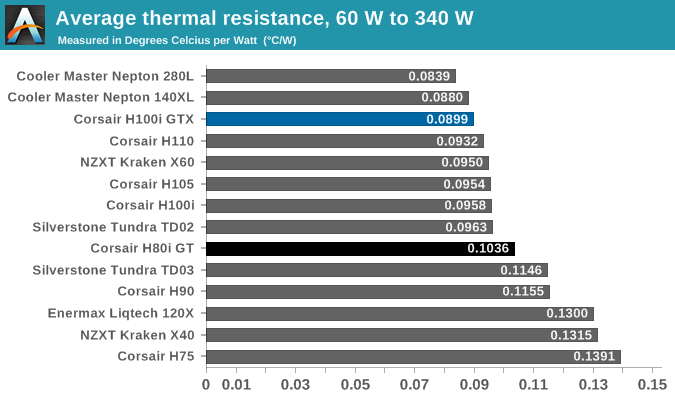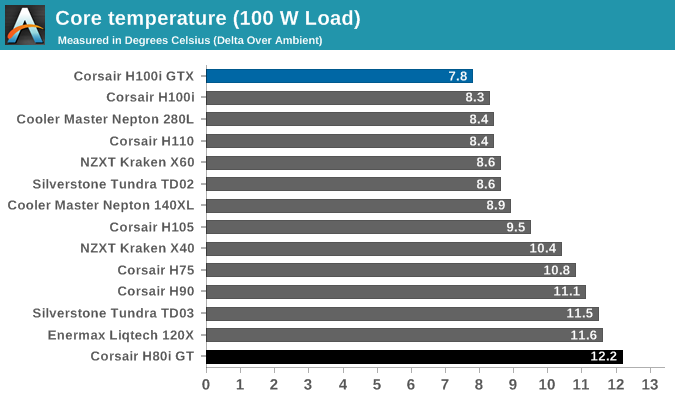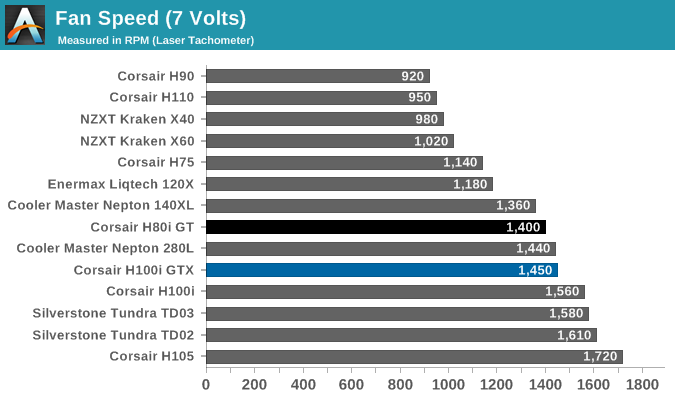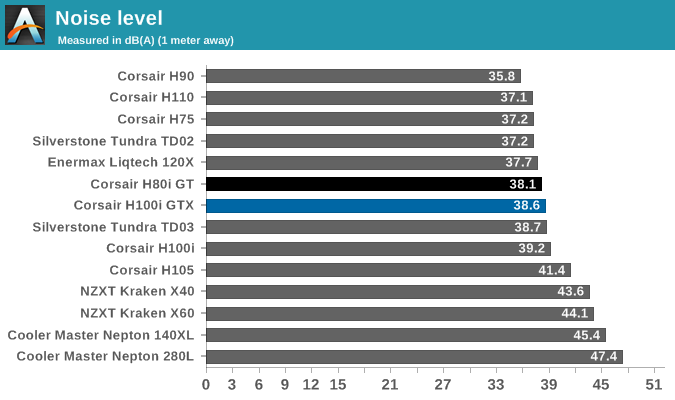The Corsair H80i GT and H100i GTX AIO Coolers Review
by E. Fylladitakis on November 16, 2015 8:00 AM EST- Posted in
- Cases/Cooling/PSUs
- Corsair
- Liquid Cooling
- Corsair Link
Testing Results, Low Fan Speed (7 Volts)
Shifting gears, let's take a look at performance with the fan speeds lowered and the fans fed at just 7 Volts.


| Core Temperature, Constant Thermal Load (Low Fan Speed) |
The H100i GTX continues to impress us when its fans and pump voltage is reduced down to 7 Volts. Once again, it displays the best low load performance of all AIO coolers. The high load performance also remains excellent, outpacing even Corsair's own H110 that is using a 280 mm radiator. Otherwise Cooler Master's models outpace the H100i GTX under heavy loads and on the average thermal resistance, but their noise output is about 8 times higher.
Not unexpectedly, the H80i GT fares better that most other similarly sized coolers when the supply voltage is reduced to 7 Volts. The low load performance is a little weak but it improves as the load increases, competing with much larger radiator AIO coolers under heavy loads. The average thermal resistance of the H80i GT is significantly better than that of similarly sized coolers and comes closer to the performance of 240/280 mm radiator coolers.


Ultimately neither the H100i GTX or the H80i GT are actually quiet when operating at 7 Volts, however the noise levels are comfortable for everyday use. The primary improvement, in our opinion, is that the whining noise of the pump is now nearly imperceptible. Even though that kind of noise would not raise the dB(A) figures by a significant amount, its high pitched frequency would be intolerable to the majority of users.










47 Comments
View All Comments
Beararam - Wednesday, November 18, 2015 - link
Oh, I never doubted your honesty about the numbers you're getting from realtemp, or aida, or whatever. It doesn't matter what they tell you though; if you're getting below ambient on an AIO or air cooler... it's wrong, because the medium you are cooling with is the air in that room.weewoo87 - Thursday, September 15, 2016 - link
Is your PC on the floor next to your AC vent? The air coming out of your AC vent will be cooler than ambient.xthetenth - Monday, November 16, 2015 - link
Good review, but I'd really like to see two things. First if you could pick a good noise level for use without headphones and normalize to that if possible for the product so we could see what lowering some of the more aggressively tuned coolers to a level that's bearable to listen to. Second, I'd love to see whether or not the coolers can be set to an inaudible or at least very quiet idle setting, and if so how much heat they can dissipate effectively in that setting.Adding those and mixing in some air coolers (probably one or two of the high end kilo of metal hanging off your socket coolers, and a stock cooler and 212 as a baseline) would make the reviews fantastic and a source for all the information I'd want when looking at coolers.
rhysiam - Monday, November 16, 2015 - link
+1 for the first request... pick a nice acceptable target level in dBA and a fairly average OC'd CPU thermal load and see what temps the coolers can manage. The chart topping temps for these coolers are completely irrelevant for the overwhelming majority of users because of the noise levels. I suspect most coolers would produce impressive temps if they have a jet engine pushing air through them.I realise it's not a perfect comparison, dBA is not a perfect measure of how intrusive the noise levels are, and no doubt people would quibble over whatever dBA and wattage you decided on. BUT, sometimes you just want a quick chart that gives a reasonably accurate reflection of performance under relatively "normal" enthusiast workloads, and temps over ambient at a fixed dBA & wattage would give you that.
To the author - I really appreciate your scientific approach. Thanks for the article and I look forward to seeing the comparison with the high Noctua's in future too.
thekdub - Monday, November 16, 2015 - link
Is 1400RPM the lowest these coolers will get using the Corsair Link software? My H100i idles at ~900RPM using a Swiftech PWM hub and is not only inaudible from ~2-2.5 feet away, but also maintains sub-30*C idle temps in a 23*C room with a 4970k. Even at load, the cooler is inaudible (or at least not noticeable) while wearing a pair of open-back headphones.If these new coolers are indeed quieter than the preceding H100i/H80i, then "quiet but tolerable" seems like it is selling them short. You can make these things silent with a custom fan curve and still achieve adequate cooling.
As a side note, I do think the older H100i/H80i have a much more sleek and attractive appearance. The two-tone grey/black on these new ones looks plasticky and cheap.
nmm - Monday, November 16, 2015 - link
Such a pity the H110i GTX wasn't in the mix, while you were at it. That really seems like the one worth looking at for anyone who has room for it. Let's face it, if you are in the market for this much cooling, you're probably in the market for as much as you can get for the least noise, which is the H110i GTX.Still, after seeing the figures and description of the H100i GTX pump noise I'm more comfortable sticking with big air for my next build.
Awful - Monday, November 16, 2015 - link
Still using my original H100 on i2500K @ 4.8GHz. Still see no good reason to upgrade either. Nice!lorribot - Monday, November 16, 2015 - link
There are a couple of real world tests that seems to be missing but may actually be quite useful, firstly cooling performance at a given noise level say 35/40/45db rather than at a given voltage or or how noisy is a system to maintain a 200w load at a say a temperature of 80C.mobutu - Tuesday, November 17, 2015 - link
www.silentpcreview.com constant ambient conditions during their testing are 10~11 dBA and 21~23°C.Anything above 20 dBA is rightfully considered loud.
You need to learn your lesson and stop bullshitting with the following laughable arguments, cause you clearly don't know what inaudible and loud really means:
- "The noise floor of our recording equipment is 30.2-30.4 dB(A), which represents a medium-sized room without any active noise sources.";
- "<35dB(A) = Virtually inaudible";
- "35-38dB(A) = Very quiet";
- "38-40dB(A) = Quiet".
HollyDOL - Tuesday, November 17, 2015 - link
Please review your lessons of physics or at least use google before you start accusations, one of many: http://www.cdc.gov/ncbddd/hearingloss/sound.html